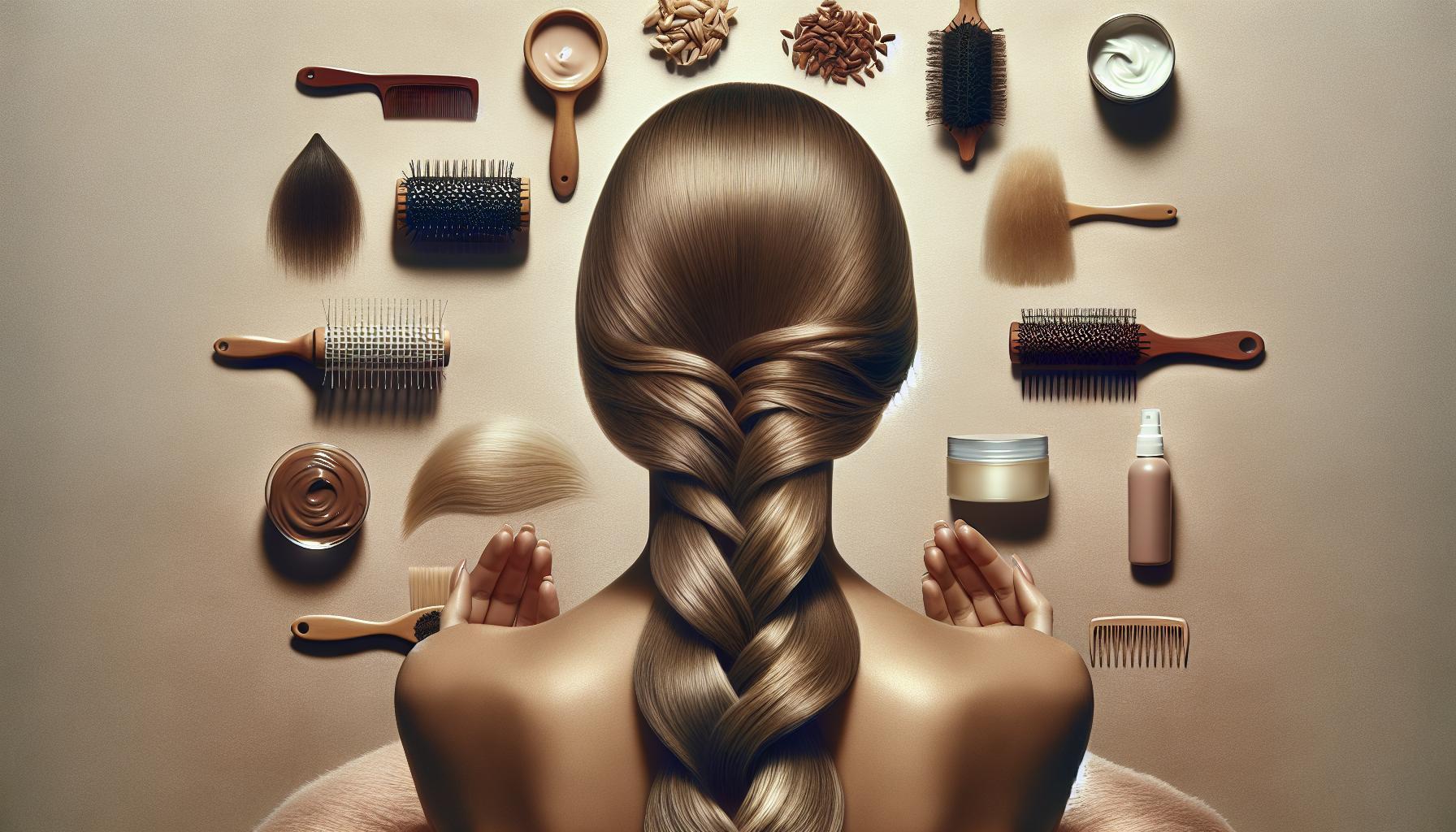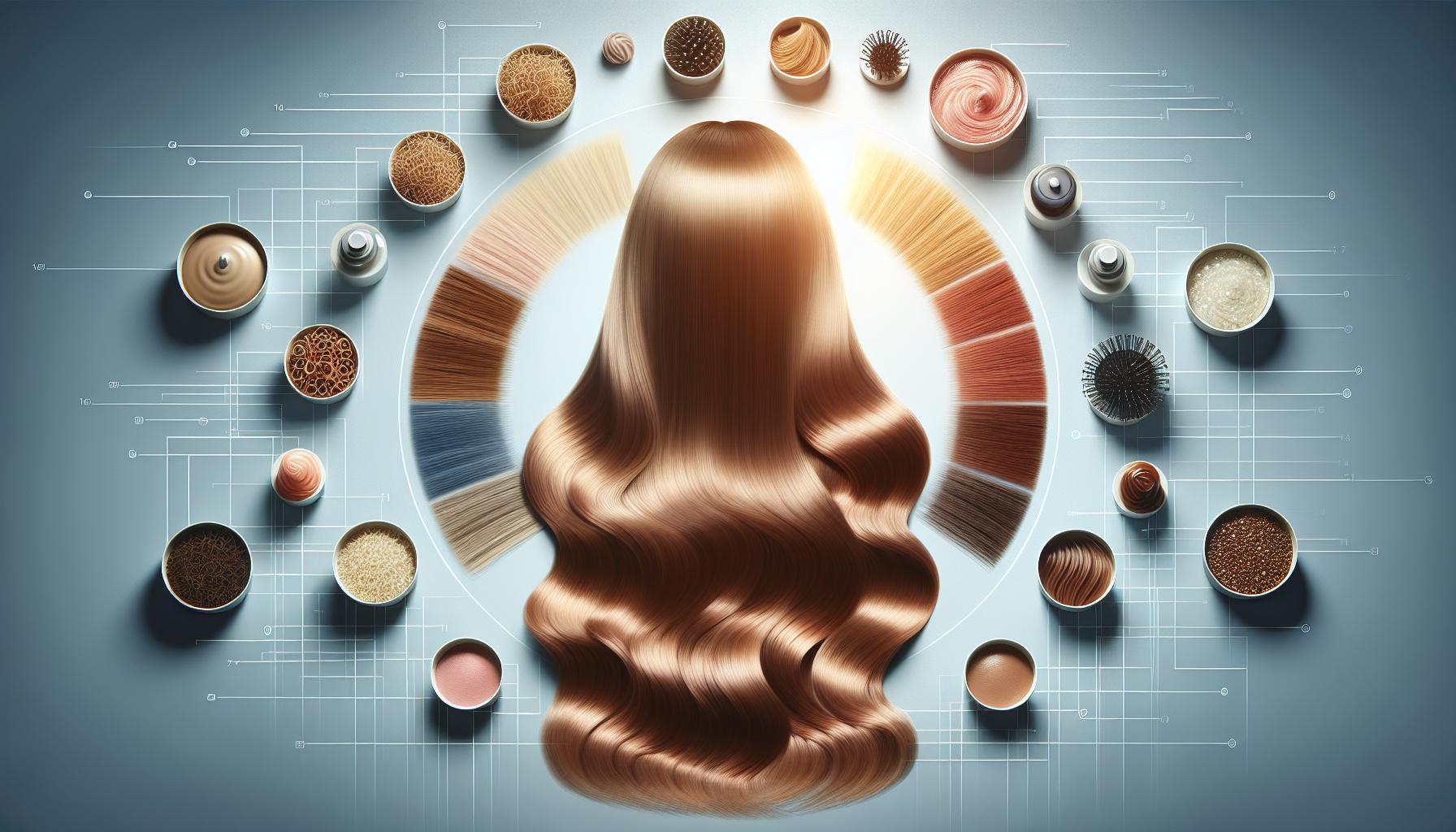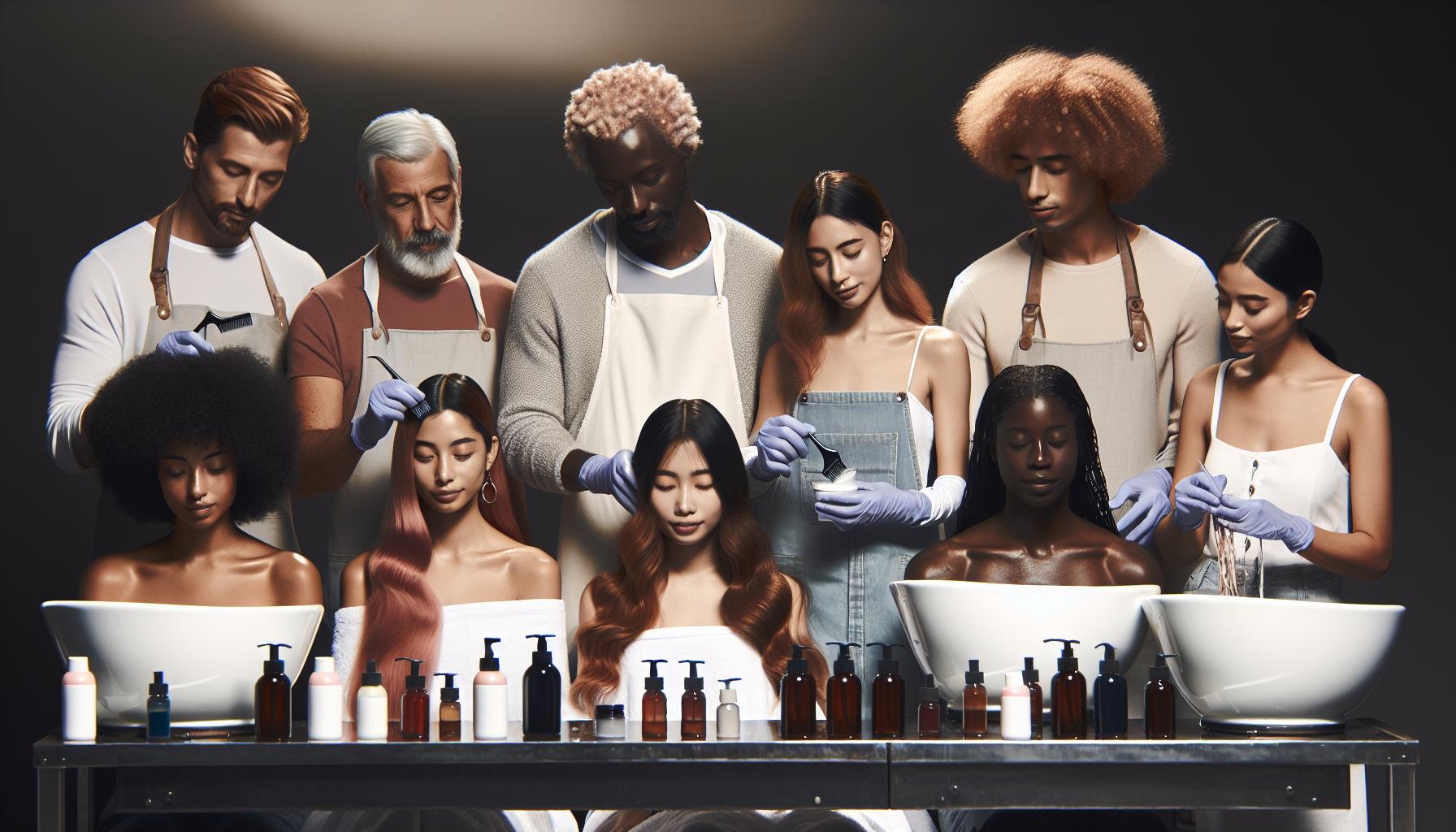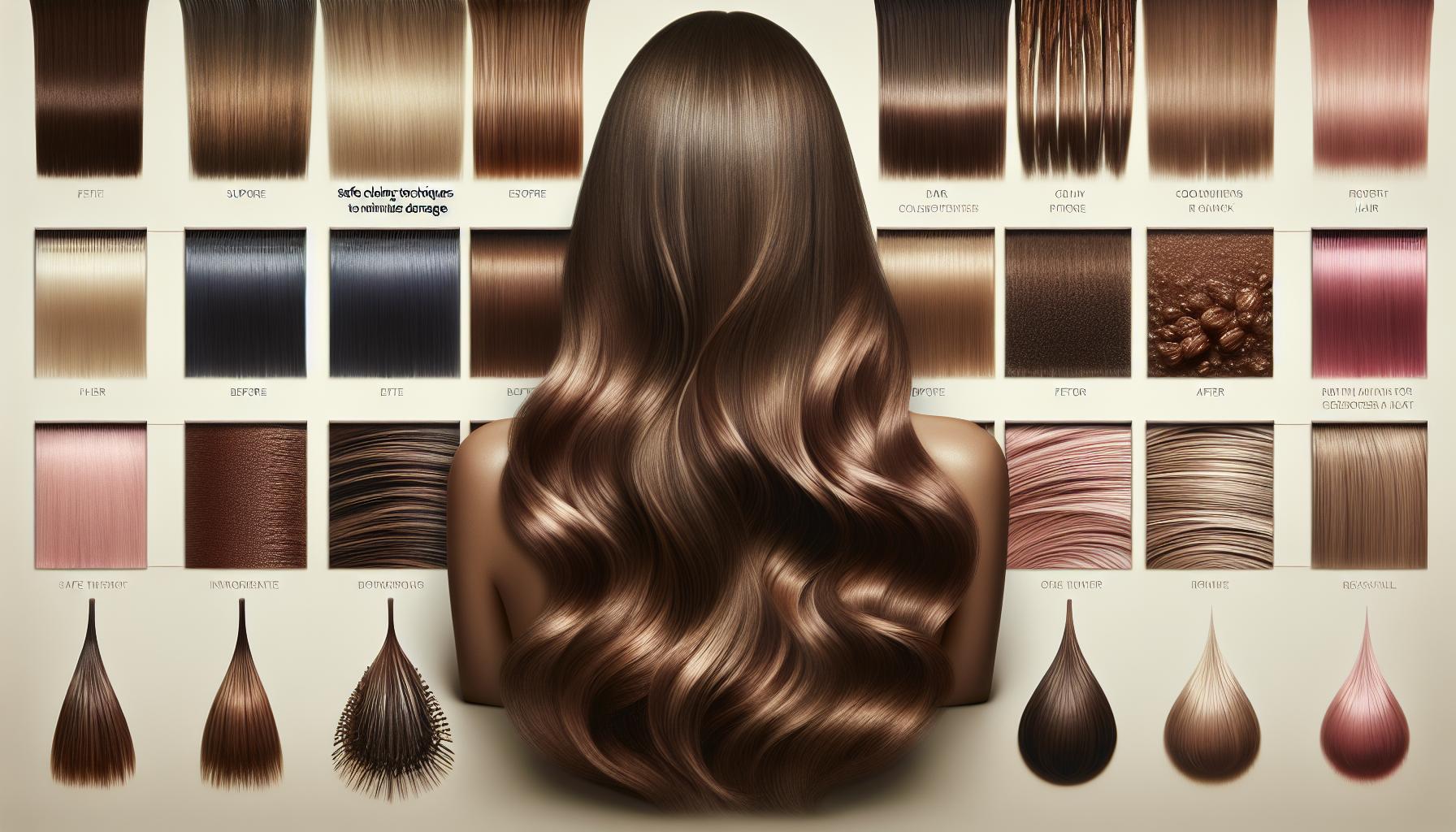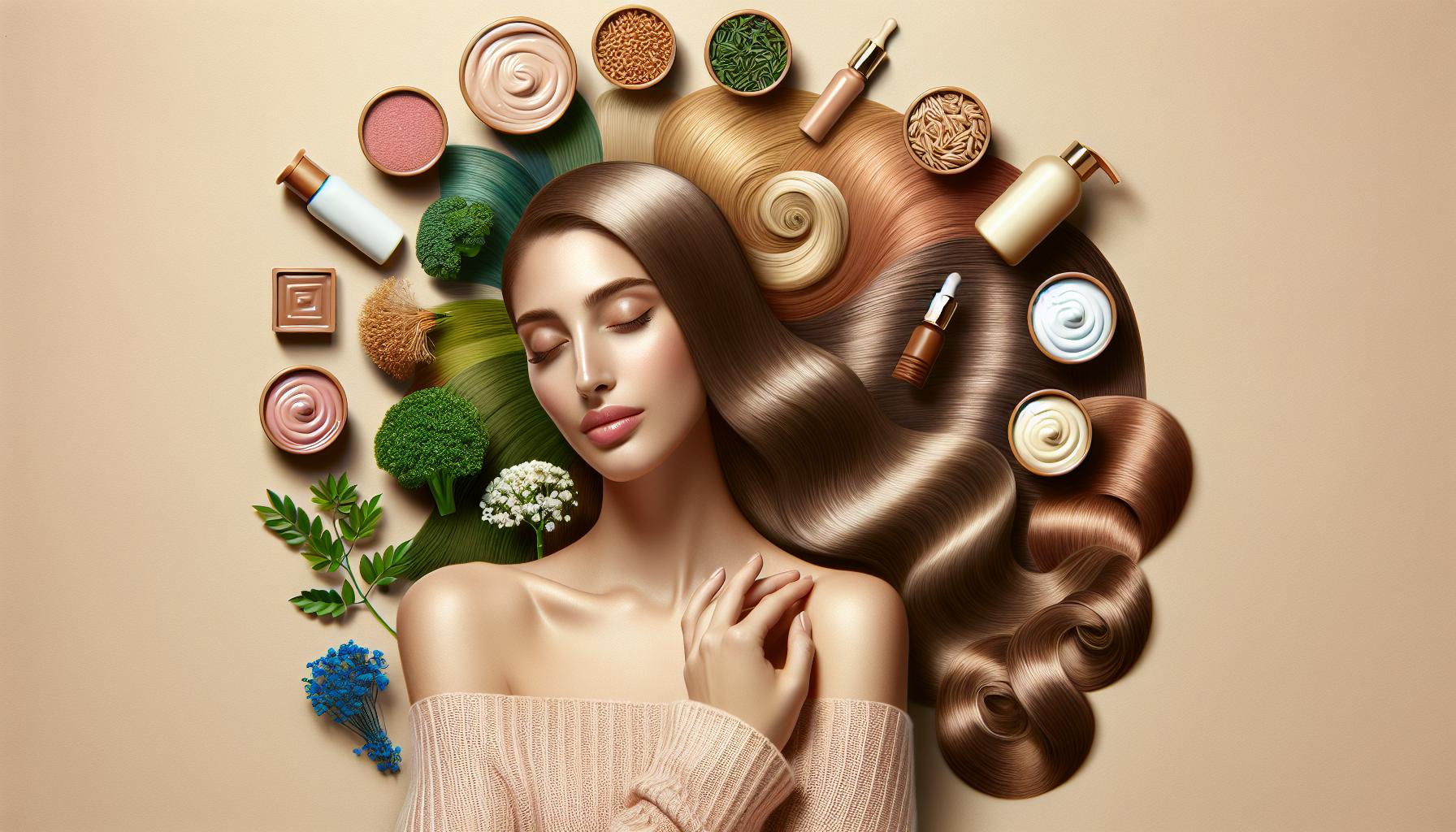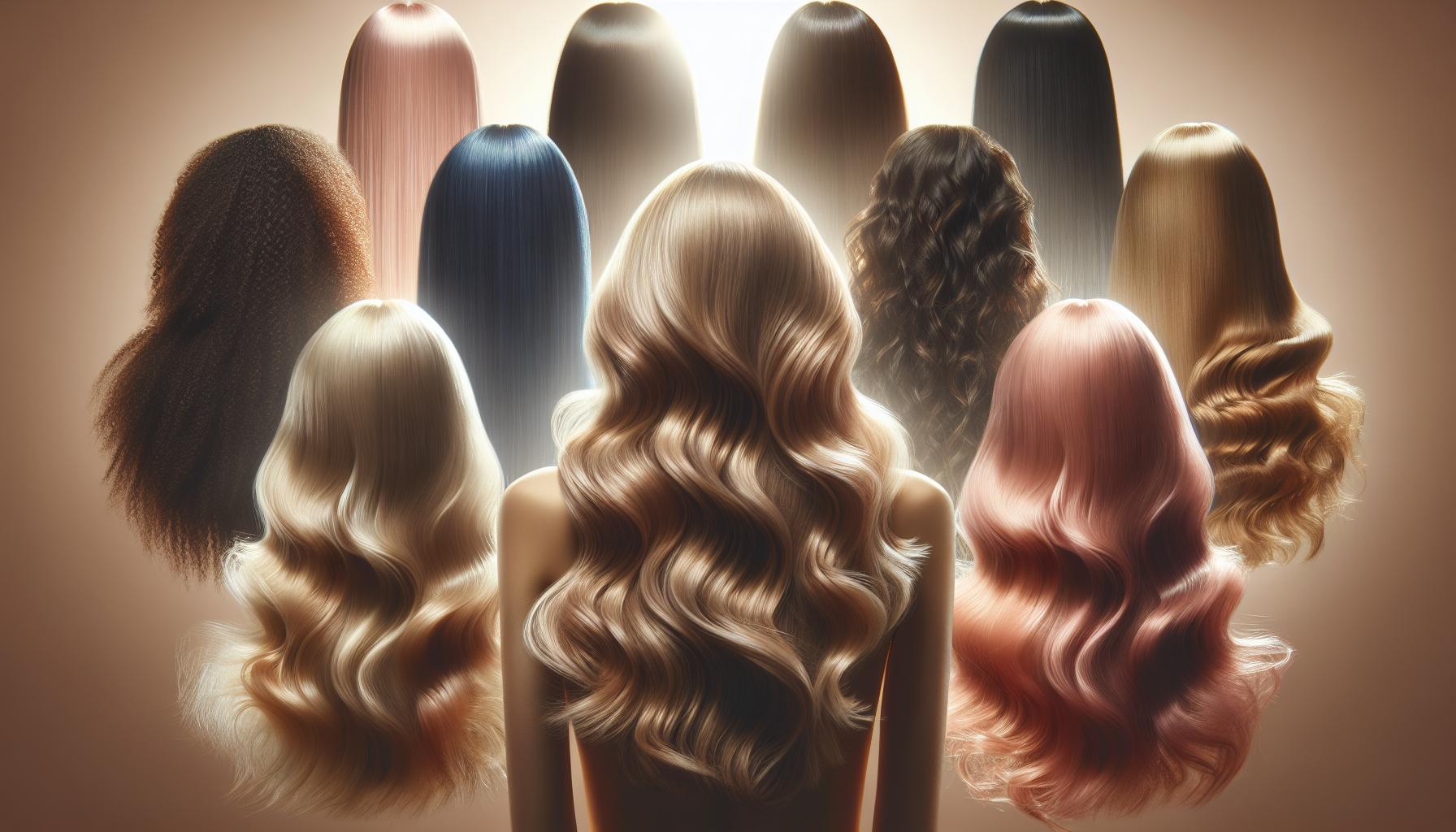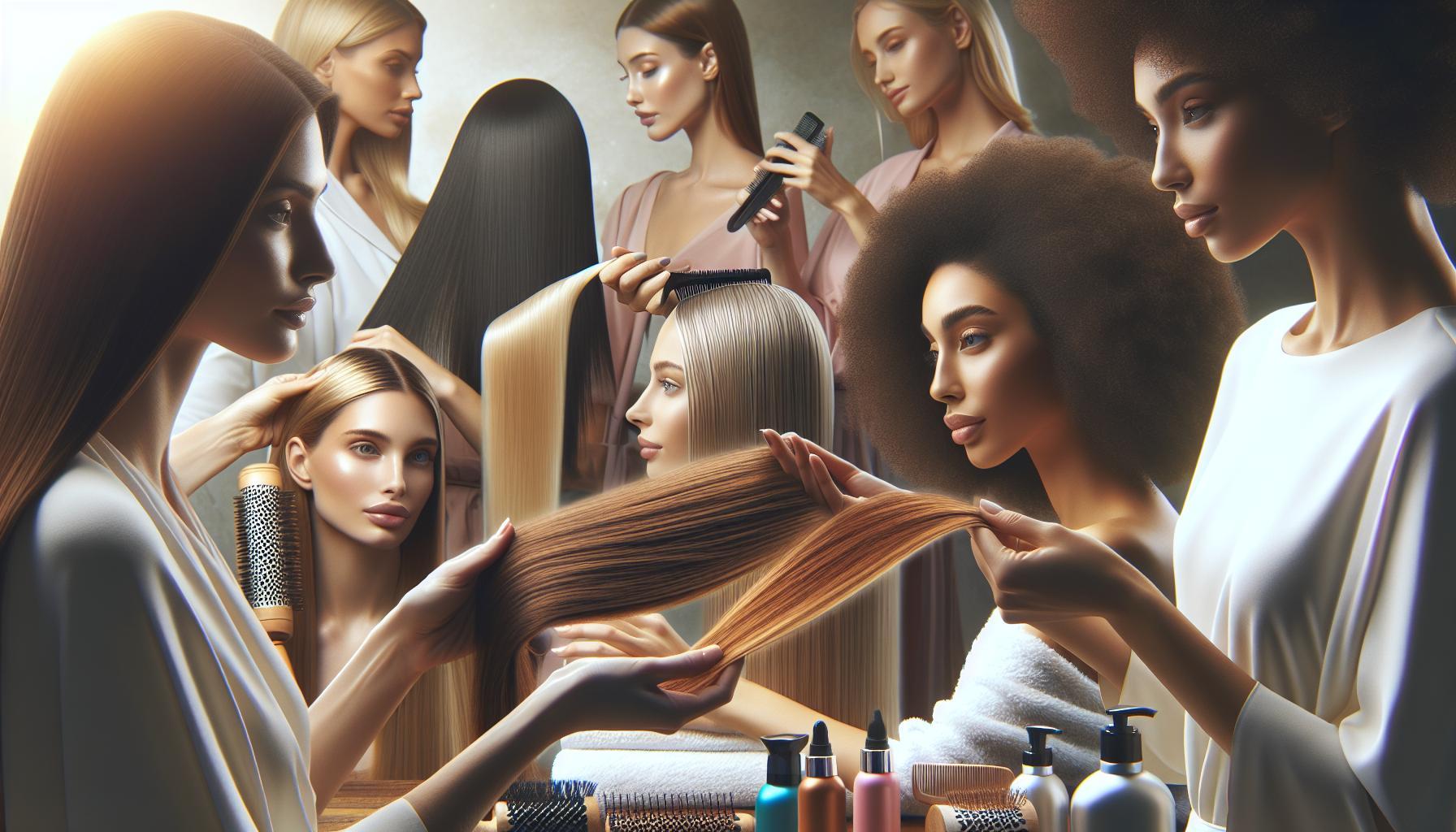Are you worried that your lovely new hair colour could be causing irreversible damage? Many people wonder about the effects of dyeing on their hair’s health. Understanding the real impact of hair coloring is essential,as it not onyl affects your locks’ appearance but also their overall strength and vitality.
Contents
- Understanding Hair Structure: How color Affects Your Strands
- The Science Behind Hair Color: What Happens During the Dyeing Process
- common Myths About Hair Coloring and Damage: Debunking Misconceptions
- Professional Insights: Safe Coloring Techniques to Minimize Damage
- Essential Aftercare Tips: Nourishing Your Colored Hair for Longevity
- Choosing the Right Products: What to Look for When Caring for Dyed Hair
- Emotional Impact of Hair color: Navigating Your Hair Journey with Confidence
- Preventative Measures: How to Protect Your Hair Before, During, and After Coloring
- Frequently Asked Questions
- The Conclusion
Understanding Hair Structure: How color Affects Your Strands
The interplay between hair color and hair health is a topic of notable interest, especially for those who frequently change their look. Color treatments can profoundly affect the structure of hair strands, leading many to wonder about the actual impact. Understanding this relationship begins with examining the basic components of hair and how chemicals used in coloring can interact with these elements.
How Color Affects Hair Structure
Hair is primarily composed of a protein called keratin, wich forms the hair shaft. The hair structure consists of three layers: the outer cuticle, the middle cortex, and the inner medulla. The cuticle provides a protective layer, with overlapping scales that shield the inner layers. When hair is colored, particularly with permanent dyes, the cuticle is lifted to allow the dye to penetrate into the cortex. This process can lead to potential damage if not done carefully.
When considering the question, does hair color damage hair?, it’s crucial to think about the specific ingredients in hair dye. Many dyes contain ammonia or peroxide, which can strip moisture and weaken the hair structure over time. Color-treated hair often requires additional care to maintain its health. Incorporating moisturizing treatments and gentle shampoos can help mitigate damage.
Practical Tips for Healthy Color-Treated Hair
To keep your strands looking vibrant without compromising their integrity,consider the following:
- Choose quality products: Invest in sulfate-free shampoos and conditioners designed specifically for color-treated hair.
- Limit heat styling: Excessive heat can exacerbate damage, so opt for air-drying when possible.
- Regular trims: Trim your ends every 6-8 weeks to eliminate split ends and promote healthier-looking hair.
- Hydrate: Use deep conditioning treatments weekly to nourish and hydrate your hair.
the impact of hair color on hair health is multifaceted. By understanding hair structure and implementing thoughtful care strategies, you can enjoy the aesthetic benefits of hair coloring while minimizing potential damage. Always remember that healthy hair begins with informed choices about products and techniques, ensuring you can confidently rock your new hue without adverse effects.
The Science Behind Hair Color: What Happens During the Dyeing Process
When it comes to changing your hair color, science plays a pivotal role in the transformation process. Understanding what occurs at a molecular level can offer insights into concerns about whether hair color damages hair—information highlighted in discussions around “Does Hair Color Damage Hair? Understanding the Real Impact.” To effectively alter hair pigmentation, various chemical reactions are employed, each with distinct implications for hair health.
The dyeing process primarily involves three key stages:
1. Oxidation
When you apply hair dye, especially permanent color, an oxidizing agent (usually hydrogen peroxide) activates.This step is crucial as it helps to lift your natural hair color or pigment. The oxidizing agent opens the hair cuticle, which is the outer layer, allowing color molecules to penetrate the inner structure of the hair (the cortex). While this process is necessary for dye penetration,it also can lead to a loss of moisture and a weakened hair structure if not properly managed.
2.Color Development
Following oxidation, the dye molecules begin to develop within the hair. In this stage, the small dye molecules bond to your hair’s natural keratin and form larger structures, effectively locking in the new color. Additionally, this bonding has the potential to alter the integrity of hair. Commitment to proper aftercare products is essential in this phase to reduce color fading and maintain strength.
3. Closure and Retention
After the color request, it’s vital to close the cuticle back down.Conditioners and specialized hair treatments can help ensure the cuticle seals after dyeing, retaining the new color while mitigating damage. Neglecting this step can lead to color washout and increased susceptibility to environmental stressors.
- Choose quality hair dye products: Look for brands that prioritize hair health.
- Incorporate conditioning treatments: Regularly use deep conditioning masks to restore moisture.
- Avoid heat styling: Limit the use of hair dryers and straighteners post-dyeing.
While the question remains—does hair color damage hair?—a well-planned application and aftercare routine can significantly minimize adverse effects. Understanding these chemical processes equips individuals with the knowledge to navigate their hair color choices thoughtfully, ultimately placing focus on both desired aesthetics and health outcomes. Knowing how to care for colored hair can emphasize vibrancy while mitigating the often-discussed risks associated with chemical alterations.
common Myths About Hair Coloring and Damage: Debunking Misconceptions
Hair color has long been a subject of intrigue and apprehension,especially when it comes to its effects on hair health. There’s a prevalent belief that coloring hair leads to irreversible damage, but is this notion firmly grounded in reality? With the rise of advanced hair coloring techniques and products designed to minimize harm, it’s essential to separate fact from fiction. Below are some of the common myths surrounding hair color and damage:
Myth 1: Hair Color Always Causes Significant Damage
Many people assume that all hair dyes, especially permanent options, must lead to a significant decline in hair quality. While it’s true that some formulations contain harsh chemicals, advancements in the beauty industry have introduced gentler alternatives. Modern hair dyes frequently enough include nourishing ingredients designed to protect and repair hair during the coloring process. For example,brands now incorporate oils or proteins to help mitigate damage.
Myth 2: Lightening Hair Is More Damaging Than Coloring It Dark
Another common misconception is that lightening hair thru bleaching is far more damaging than simply applying darker dye. While it is true that bleach can strip the hair of moisture and cuticle integrity, any hair color application can potentially cause some damage if not applied or maintained properly. It’s essential to understand that both processes can be done with minimal harm if the right techniques and products are used. Regular conditioning treatments and deep conditioning masks can definitely help restore vitality irrespective of the color choice.
myth 3: Natural hair Dye Options Are Damage-Free
In the quest for healthier hair, many turn to natural hair dyes, believing they pose no risk of damage. While plant-based dyes like henna can be gentler on the hair, they are not inherently risk-free. Just like chemical dyes, natural products can lead to dry or porous hair if not used with care. To achieve the desired results, it’s crucial to follow the instructions properly and consider conducting a patch test to measure hair’s reaction.
Myth 4: You Can’t Color Damaged Hair
It’s not uncommon for individuals with damaged hair to feel that coloring is off-limits. However, this isn’t always the case. If your hair is damaged but not overly brittle or breaking, you can still enjoy coloring sessions. The key is to choose the right products and techniques. Consider semi-permanent dyes, which are less harsh than permanent ones, and always ensure to precondition your hair. Here’s a table summarizing the types of hair dye and their relative impact on hair health:
| Type of Hair Dye | Impact on hair | Recommended for |
|---|---|---|
| Permanant Dye | Higher risk of damage, especially with bleach | Healthy hair or well-prepped damaged hair |
| Semi-Permanent Dye | Generally gentler, less long-lasting | Dull hair or for a temporary change |
| Natural/Plant-Based | Varies; can still cause some damage | Those seeking organic options |
By debunking these common myths, one can approach hair coloring with greater confidence and understanding. With the right knowledge, tools, and products, anyone can achieve a vibrant hair color while maintaining hair health.
Professional Insights: Safe Coloring Techniques to Minimize Damage
Coloring your hair can feel like a transformative experience, but many worry about its potential to damage their locks. Fortunately, there are safe coloring techniques that can minimize harm while allowing you to express your style. Understanding the real impact of hair color on your strands is the first step toward maintaining healthy hair even after changing its hue. Let’s explore some professional insights into actively preserving your hair’s integrity while coloring.
Choose Quality Products
One of the most significant steps to prevent damage is opting for high-quality hair color products. Look for options that are free from harsh chemicals like ammonia and parabens. Brands now offer nourishing formulas enriched with natural oils or botanical ingredients, which not only provide vibrant color but also condition the hair. Prioritizing products with labels that highlight moisture and repair can significantly reduce the risk of damage.
Employ proper Techniques
Using the correct application techniques can shield your hair from excessive damage. Here are some tips to keep in mind:
- Strand Testing: Always perform a strand test before coloring the entire head. This helps you understand how your hair reacts to the dye and adjusts the timing accordingly.
- Full vs. Touch-Up: Consider full color applications less frequently and focus on touch-ups for roots to minimize exposure to chemicals.
- Heat Protection: If using heat to activate the color, ensure to apply a thermal protectant. This prevents overheating and damage to your strands, further safeguarding your hair.
- Apply Strategically: For those with long hair, apply the dye mid-length to the ends first, as they tend to be more porous and absorb color faster.
Post-Color Care
Your hair’s health doesn’t end with application. Post-coloring care is crucial for maintaining your strands. Use sulfate-free shampoos and conditioners designed for colored hair. These products help retain moisture and prevent color fading, making your color last longer while also reducing dry, brittle hair.Additionally, consider incorporating a weekly deep conditioning treatment to restore hydration.
Table of Recommended Products
| Product Type | Recommended Ingredients | Examples |
|---|---|---|
| Hair Color | Ammonia-free, Natural Oils | olaplex Hair Color, Naturtint |
| Shampoo | Sulfate-free, Moisturizing | Pureology Hydrate Shampoo, Moroccanoil Hydrating Shampoo |
| Conditioner | Color protecting, Nourishing | Redken Color Extend, Joico Color Balance |
By understanding how to safely color your hair, it’s possible to enjoy vibrant hues without sacrificing its health. Being informed about the potential effects and employing strategic techniques can lead to beautiful results without the worry of irreversible damage.
Essential Aftercare Tips: Nourishing Your Colored Hair for Longevity
Colored hair can be a stunning expression of personal style, but the process of dyeing can leave your locks craving extra love and care. Understanding the real impact of hair color on hair health is essential, especially when it comes to maintaining vibrancy and avoiding damage. To keep your mane looking salon-fresh while minimizing any adverse effects, here are some essential aftercare tips tailored specifically for colored hair.
Hydration is Key
Moisture plays a pivotal role in the health of your colored hair. Dyeing can strip your strands of their natural oils, leading to dryness and brittleness. Here’s how to ensure your hair stays hydrated:
- deep conditioning: Integrate a deep conditioning treatment into your routine at least once a week. Look for products specifically formulated for color-treated hair, which can help restore moisture and repair damage.
- Leave-In Conditioners: Incorporate a leave-in conditioner. This provides ongoing hydration throughout the day, making your hair more manageable and reducing frizz.
- hydrating Masks: Use hair masks that contain ingredients like coconut oil or shea butter to infuse moisture and nourishment back into your strands.
Protect Against Heat and Environmental Damage
Exposure to heat styling tools and environmental elements can exacerbate the damage caused by hair color.To combat this, consider the following strategies:
- Minimize Heat Use: Avoid excessive use of blow dryers, straighteners, and curling irons. When you do heat style, use a thermal protectant spray to shield your hair from damage.
- Wear UV Protection: Just like your skin, your hair can suffer from UV damage. Choose hair products with UV filters or wear a hat when you’re out in the sun.
- Avoid Chlorine: If you swim in pools, use a swimming cap and rinse your hair before and after a swim to minimize chlorine exposure, which can dull and damage color.
Choose the Right Products
The products you use post-coloring can significantly affect both your color lifespan and hair health. Here are essential considerations:
| Product Type | Why It’s Vital |
|---|---|
| Shampoo: Sulfate-Free | Helps to preserve color and prevent premature fading. |
| Conditioner: Color-Saving | Boosts moisture and can minimize the color washout effect. |
| Styling Products: Alcohol-Free | Reduces the risk of drying out hair and allows for better adaptability. |
By following these essential aftercare tips, you can nourish your colored hair and enhance its longevity while understanding the real impact that hair color processes can have. Take the time to invest in your hair care routine, and you’ll enjoy vibrant, healthy-looking locks for much longer.
Choosing the Right Products: What to Look for When Caring for Dyed Hair
Maintaining the vibrancy and health of dyed hair can feel like an uphill battle, especially when faced with a myriad of products on the market. Choosing the right products is essential in mitigating potential damage associated with hair coloring. Certain products can either enhance your hair’s health or accelerate its deterioration. By being informed about what key ingredients and features to look for, you can keep your hair looking its best while ensuring its resilience against the effects of color treatment.
Key Ingredients to Seek Out
When selecting products for dyed hair, it’s vital to prioritize those with nourishing ingredients that help protect the hair shaft.Look for:
- hydrating agents: Ingredients like glycerin, aloe vera, and various oils (such as argan or coconut) help to retain moisture, making your hair less prone to dryness and brittleness.
- UV protectants: Sun exposure can fade hair color. Products with UV filters help shield your hair from harmful rays,preserving your color’s vibrancy.
- protein-rich formulas: Hydrolyzed silk, keratin, and wheat proteins can strengthen and fortify your hair, repairing damage that may have occurred from the coloring process.
- Sulfate-free cleansers: Products labeled as sulfate-free are gentler on color-treated hair, as sulfates can strip the hair of its natural oils and lead to quicker color fade.
avoiding Harmful Ingredients
Just as important as knowing what to look for is understanding what to avoid. Some ingredients can exacerbate damage:
| Harmful ingredients | Reasons to Avoid |
|---|---|
| Sulfates | They can strip color and moisture, leading to dryness and fading. |
| Alcohols | Certain types (like ethanol) can dry out and damage the hair. |
| Parabens | Tho controversial, some prefer to avoid parabens as they can irritate the scalp and lead to other issues. |
Choosing the right Products for Your Routine
along with individual products, consider your hair care routine holistically. Use a sulfate-free shampoo and a rich, moisturizing conditioner specifically formulated for color-treated hair. Incorporating a weekly deep conditioning mask can inject extra moisture and nutrients into your hair, helping counteract damage caused by the dyeing process. A leave-in conditioner or hair oil can also act as a protective barrier against heat and UV exposure, extending the life of your color.
By understanding the effects of hair color on your strands and choosing the right products, you can keep your hair healthy and vibrant. The journey of caring for dyed hair may seem daunting, but with the right tools and knowledge at your disposal, you can embrace your color without sacrificing the health of your hair.
The journey of changing your hair color is not just about aesthetics; it deeply intertwines with your emotions and self-perception. Studies have shown that the way we perceive ourselves can profoundly influence our confidence levels and overall happiness. Selecting a new hair color can evoke excitement and a fresh sense of identity, but it may also trigger anxiety about potential damage and the long-term impacts on your hair health. Understanding how your choices affect not only your hair but also your emotional well-being is crucial to confidently navigating this personal transformation.
Transformative Power of Hair Color
The transformative power of hair color is undeniable. A bold new shade can symbolize a new beginning, inspired by a significant life change or simply a desire for reinvention.Many individuals report feeling empowered and more confident after a hair color change.For example, someone transitioning from a corporate job to a creative field might opt for vibrant hues, reflecting their new identity and aspirations.
- Boosts Confidence: Changing your hair color can elevate your mood and self-esteem, enhancing how you present yourself to the world.
- Expressions of Individuality: Hair color choices allow for self-expression, enabling individuals to embrace their unique style.
- A Fresh Perspective: A new shade can shift your mindset,motivating you to approach challenges with renewed vigor.
However, accompanying these benefits are the concerns about hair damage. To tackle these worries, here are essential tips to maintain healthy hair while exploring the realm of color:
Minimizing Damage while Coloring
- Choose Quality Products: Invest in high-quality hair dyes and pre-treatment products that nourish your hair.
- Consult Professionals: Seek advice from experienced colorists for personalized recommendations based on your hair type.
- Regular Conditioning: Maintain a robust conditioning routine to keep your strands hydrated and resilient post-coloring.
- Limit Heat Styling: Reduce the use of hair dryers and styling tools that can exacerbate damage.
Understanding Emotional Implications
The decision to alter your hair color often carries emotional implications that can impact your journey. for some, the anticipation and excitement of a hair makeover may be overshadowed by fears regarding the potential downsides associated with hair dye. This interplay of feelings can lead to resistance or regret in some cases. Keeping a positive frame of mind can make this transition smoother. Here’s a practical approach to managing your emotional journey:
| Emotion | Strategy |
|---|---|
| Excitement | Document your journey through photos and journaling. |
| Anxiety | Research hair color maintenance to ease concerns. |
| Doubt | Seek feedback from trusted friends or a stylist. |
| Empowerment | Embrace the change and celebrate your new look. |
Navigating the emotional landscape of hair color involves embracing both the thrill of transformation and the practical aspects of hair care. By understanding the real impact of hair color, you can make informed choices that enrich not only your appearance but also your confidence and self-image.
Preventative Measures: How to Protect Your Hair Before, During, and After Coloring
Coloring your hair can be a transformative experience, allowing you to express your personality and style. However, many people dread the potential damage associated with hair dye. In fact, understanding the real impact of hair color on your hair is vital for maintaining its health. Fortunately, there are practical measures you can take before, during, and after the coloring process to shield your strands from harm.
Readiness: Before Coloring
Prioritizing hair health starts long before the dye is applied. Here are some key steps you can take:
- Deep Condition: One to two weeks prior, incorporate deep conditioning treatments into your routine. Look for products rich in proteins and hydration to strengthen your hair.
- Trim Your Hair: Schedule a trim to remove split ends and damage. Fresh hair can better withstand the rigors of coloring.
- Avoid Heat Styling: Minimize the use of heat styling tools (like straighteners and curling irons) to reduce stress on your hair before coloring.
- Test for Allergies: always perform a patch test with the hair dye 48 hours in advance to check for allergic reactions.
During the Coloring Process
When you’re in the chair ready to transform your look, consider the following to mitigate damage:
- Choose Quality Products: Opt for professional-grade hair color or, if you’re coloring at home, select brands designed with nourishing ingredients that minimize damage.
- Stay Within Your Natural Range: If possible, stick to shades that are close to your natural color. Drastic changes often require stronger chemicals that can lead to more damage.
- Follow Instructions: Always adhere to the guidelines provided with your hair dye; timing is crucial to avoid over-processing.
- Consider Semi-Permanent Options: If you’re concerned about damage, try a semi-permanent dye which can provide color without the commitment of harsher permanent formulas.
Post-Color Care
Once you’ve colored your hair, the care doesn’t stop there. Proper aftercare plays a critical role in preserving the vibrancy and health of your tresses.
- Use Color-Safe Shampoo and Conditioner: Instantly switch to products formulated for color-treated hair to maintain your color and hydration.
- Limit Washing Frequency: Washing your hair too often can strip away color and moisture. Aim for every other day or less.
- Protect from Heat: If using heat styling tools is a must,always apply a heat protectant spray beforehand to shield your strands.
- Regular Deep Conditioning: Maintain a habit of deep conditioning at least once a week to restore moisture and prevent dryness.
By implementing these preventative measures when you color your hair, you can truly enjoy the experience while minimizing the risks associated with damage. Understanding the real impact of hair color will not only empower you to make informed choices but will also pave the way for long-lasting, beautiful hair.
Frequently Asked Questions
Does hair Color Damage Hair?
Yes, hair color can damage hair, but the extent varies based on the type of dye used and how often it’s applied. For example, permanent dyes usually contain harsh chemicals that can weaken hair over time. Greater damage may occur with frequent dye jobs or improper care.
To minimize damage, consider using semi-permanent or natural dyes, which are less damaging than conventional permanent colors. Additionally, following a proper hair care routine, including using moisturizing conditioners and minimizing heat styling, can help maintain hair health. For more tips,visit our hair care page.
What are the effects of hair dye on hair health?
Hair dye can lead to dryness,brittleness,and split ends due to the chemicals used in the coloring process. These effects are most pronounced with repeated applications of permanent dyes.
Chemicals like ammonia and peroxide can strip hair of its natural moisture, leading to weakened strands. To combat these effects, focus on hydration through deep conditioning treatments and leave-in conditioners. This can significantly aid in restoring moisture and strength to color-treated hair.
Can I dye my hair without damaging it?
You can dye your hair with minimal damage by opting for less harsh products and taking care of your hair pre- and post-dye. Using semi-permanent dyes or natural alternatives like henna can help reduce damage.
Before dyeing, ensure your hair is well-conditioned and healthy. After coloring, maintain a frequent conditioning routine and use sulfate-free shampoos to protect your hair from further drying out. Regular trims can also help in keeping split ends at bay.
Why does hair damage occur when coloring?
Hair damage occurs during coloring mainly due to the chemical processes that alter the hair structure. These processes can weaken the hair’s protein structure, leading to a loss of moisture and elasticity.
When chemicals in hair dye penetrate the hair cuticle, they can cause it to swell, which disrupts the hair’s integrity. Continuous exposure to these chemicals, especially with permanent colors, can exacerbate damage. Therefore, understanding the formulation of the dye you choose is crucial.
How often can I dye my hair without causing damage?
Generally, it’s advisable to wait a minimum of 4-6 weeks between coloring sessions to reduce potential damage. This time allows your hair and scalp to recover from the chemical processes.
During this recovery period, it’s beneficial to nourish your hair with deep conditioning treatments and protective hairstyles. If you’re using less harsh dyes, such as semi-permanent ones, you may have more flexibility with timing. Always monitor your hair’s response after dyeing.
What can I do to repair damaged hair after coloring?
To repair damaged hair post-coloring, focus on hydration, protein treatments, and minimizing heat exposure. Hydrating shampoos and conditioners specifically designed for color-treated hair can definitely help restore moisture.
Incorporating weekly deep-conditioning masks can also rejuvenate your hair. Look for products containing ingredients like keratin or argan oil, which can aid in restoring strength and shine. Remember,patience and consistent care are key!
Can natural hair dyes prevent damage?
Yes, natural hair dyes tend to be less damaging than their chemical counterparts. Options like henna or indigo can provide color while conditioning the hair.
Natural dyes frequently enough lack the harsh chemicals found in traditional dyes, making them a gentler choice for those concerned about damage. However, it’s essential to realize that results from natural dyes may vary and do not always deliver the same vibrancy or longevity as synthetic products.
The Conclusion
understanding the impact of hair color on hair health is essential for making informed decisions about your hair care journey.While chemical processes involved in dyeing can potentially lead to damage, the degree of impact frequently enough depends on factors like formulation, application techniques, and your individual hair type. Knowledge is power when it comes to navigating these choices—opt for high-quality products, seek professional advice when needed, and always prioritize aftercare to maintain your hair’s integrity.
Remember,your hair is an expression of your unique style,and with the right care,you can enjoy the vibrancy of color while minimizing harm. If you’ve ever felt uncertain about dyeing your hair, take a moment to reflect on the insights shared here. By experimenting with safe practices and harnessing the benefits of nourishing treatments, you can create a routine that enhances both your hair’s appearance and health.
We encourage you to further explore the world of hair care and color options. Your hair journey is yours to define, and a wealth of resources is available to guide you along the way. Embrace the knowledge, share your experiences, and take confident steps towards achieving beautiful and resilient hair that makes you feel your best every day.

